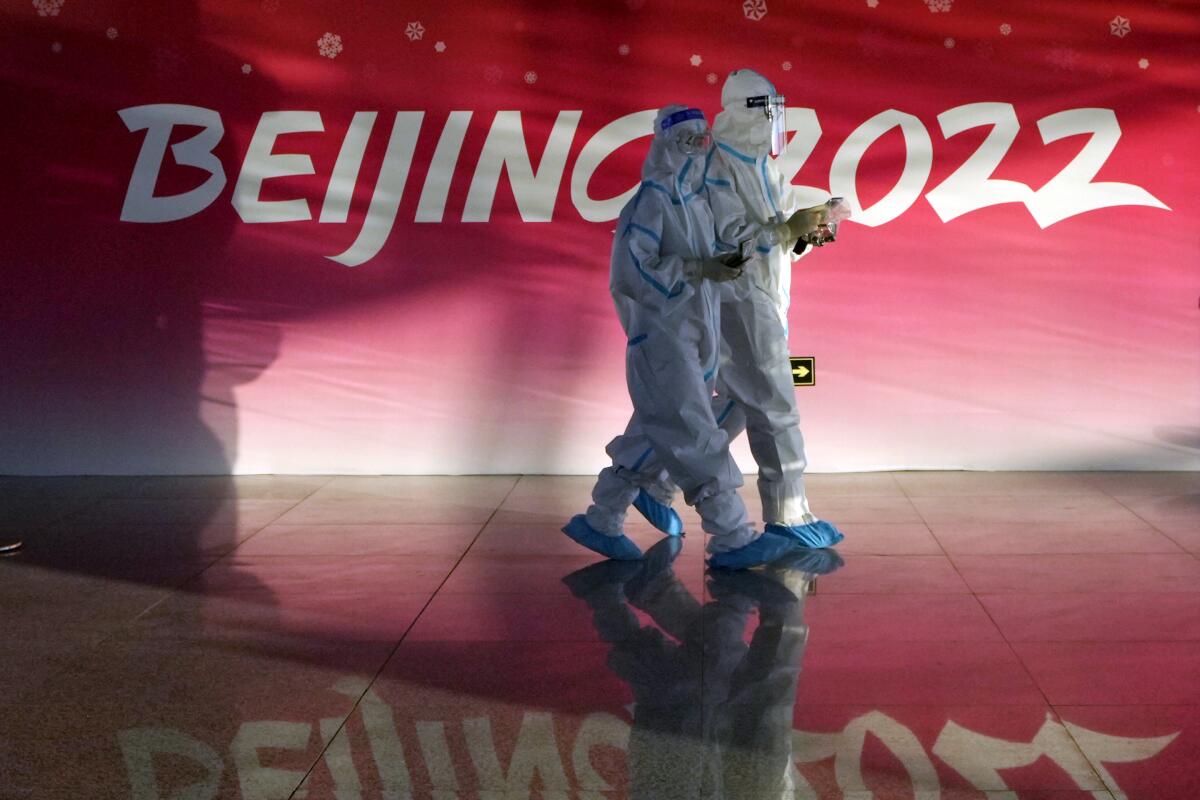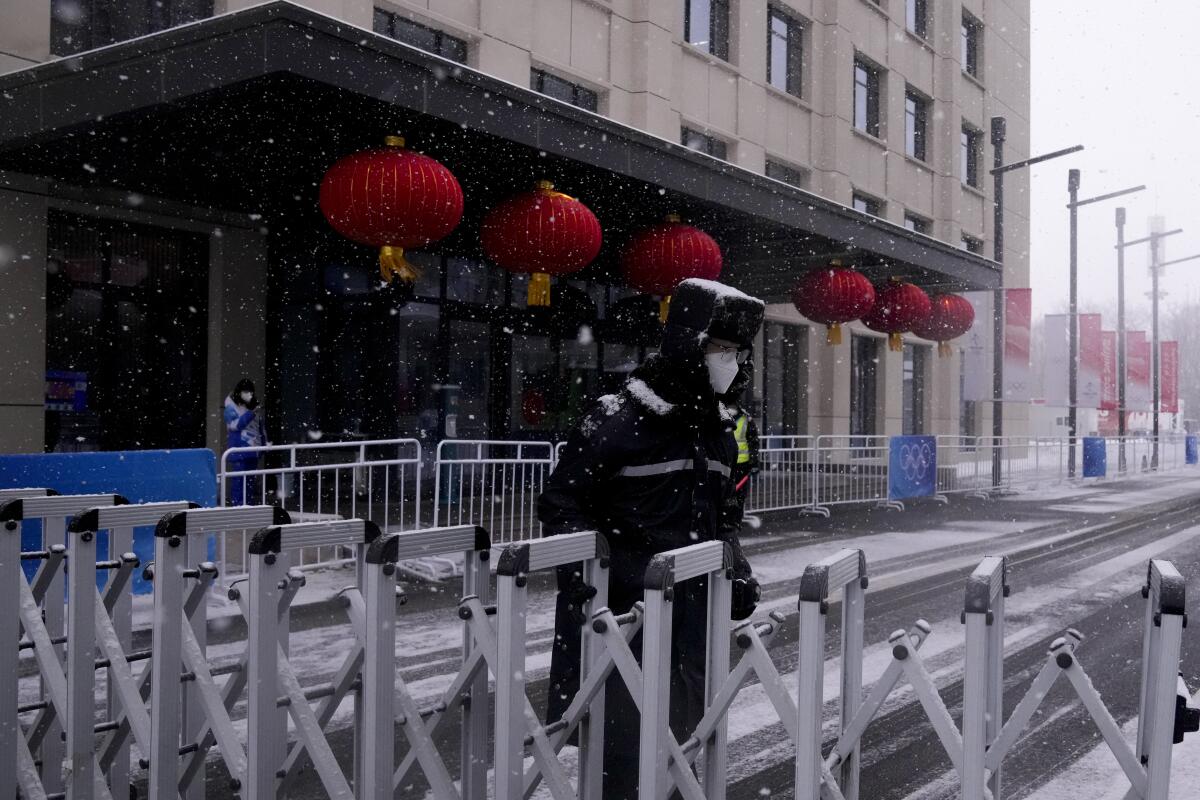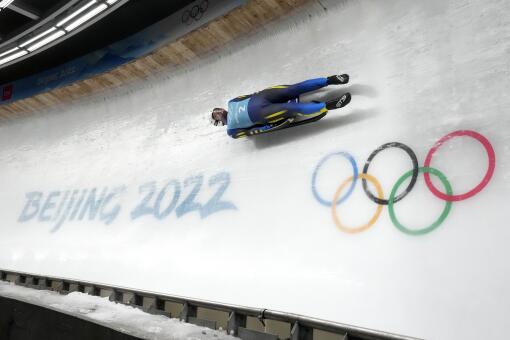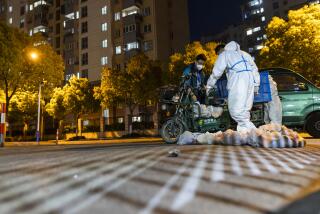China’s ‘closed loop’ Olympics limited coronavirus, even with some head-scratching measures

- Share via
BEIJING — On a recent morning, the sound of gagging from credential-holders undergoing their daily coronavirus throat swab from a woman in a hazmat suit echoed off the marble floors of a hotel inside the Winter Olympics bubble.
Nearby, two workers wearing face shields, protective aprons and booties wiped down the temperature sensor that everyone entering the hotel must pass through after stations to decontaminate their luggage and hands.
A robot spraying disinfectant into the air patrolled the walk to the breakfast buffet, where each customer encountered another temperature sensor before being issued disposable gloves and enjoying their morning coffee at tables where clear plastic dividers separated each space.
Strict, sometimes head-scratching measures to prevent the spread of the coronavirus invaded every part of daily life at the Games, echoing China’s zero-tolerance approach to the pandemic.
China is using robots to cut down on human contact and slow the spread of the coronavirus during the Olympics. It looks good as long as you aren’t in a hurry.
But the precautions — focused on the bubble that’s cut off from the rest of society — appear to have worked.
Organizers reported no new positive tests Saturday for the second time in three days, leaving the total coronavirus cases linked to the Games at 437 since Jan. 23.
“It was one of the safest places on the planet, if not the safest place on the planet,” International Olympic Committee president Thomas Bach boasted during his wrap-up news conference.
The bubble used during the Tokyo Olympics last summer, where 464 people tested positive, wasn’t as aggressive. Credential-holders served a two-week soft quarantine limiting them to approved destinations such as convenience stores and venues, then were free to travel. Everyone installed apps on their phone for contact tracing and monitoring daily health. Athletes were tested daily while others were tested every three days by spitting into a small vial, as a relatively relaxed attitude prevailed.
The Beijing Olympics were much different, with a system that organizers described as a “closed loop” based on two playbooks of regulations, starting with scores of hazmat-suited workers who greeted each planeload of arrivals at Beijing Capital International Airport.

“The success of the countermeasures means the success of the Games,” said Huang Chun, deputy director-general of pandemic prevention and control for the organizers, who noted that the regulations have been “observed very strictly.”
Every step was separated from the rest of China. Credential-holders were required to take special Olympics-only flights in and out of the country using terminals set aside for this purpose. Police, surveillance cameras and temporary walls surrounded their hotels. Even food delivery services weren’t allowed to breach the bubble.
Everyone inside had to be fully vaccinated against the coronavirus — or serve a 21-day quarantine — and could only travel on approved transportation between a small list of destinations. Each person had to enter daily health information into an app that has drawn questions about its security. Experts question the usefulness of the app because of how easy it is to make up temperatures and deny any symptoms. High-quality masks were mandatory, as were daily tests using throat swabs instead of saliva. Anyone testing positive, after a second confirmation test, was whisked to an isolation facility.
“I am pleasantly surprised by the low number of cases — not because I wouldn’t expect the controls to work — they do — but because even in closed loops or ‘bubble’ one person not following protocols to a T can result in the loop/bubble being broken,” said Marissa Baker, an assistant professor at the University of Washington who has worked on ways to protect workers from the coronavirus and tracked workplace outbreaks. “It does seem like a testament to not only the controls being strong, but also everyone being conscientious about following them in order to keep each other safe.”
Baker said that checking temperatures through the automatic systems that litter the bubble hotels and venues aren’t effective, because people could be infectious before symptoms emerge.
The exact number of people inside the bubble isn’t known, though organizers performed 70,000 daily tests at the peak of the Games. The bubble encompassed a vast range of credential-holders including athletes, team officials, journalists, hotel staff, security, bus drivers, volunteers and many more.
More than 1.7 million total tests on bubble residents turned up 171 cases, including 68 athletes or team officials since Jan. 23, with the remainder of the cases from testing at the airport on the Games-related 13,600 arrivals. The number isn’t broken down by country or sport.
Though a handful of medal contenders weren’t able to travel to China because of positive tests before the Games, the virus didn’t lead to any widespread disruptions in competitions or outbreaks in the athletes’ villages spread between three clusters of venues.
Zachary Binney, an assistant professor and epidemiologist at Emory University, noted the most effective ways to stop the spread of the coronavirus are vaccines, quickly isolating cases and keeping the virus out of the air.
“The closed loop certainly doesn’t hurt as it limits the opportunities for the virus to be introduced, but it’s not feasible in the vast majority of circumstances, and frankly the size of the loop and the fact that cases got in in the first place makes me question its usefulness,” Binney continued.

Organizers seemed to use a kitchen-sink approach. Every other seat was blocked on buses to promote social distancing, though, in practice, this was ignored. Athletes passing through mixed zones were separated from journalists by several feet, requiring shouted questions and selfie sticks to hoist recorders toward them. Volunteers held signs that read “Mask on.” Signs on floors begged for social distancing. Hand sanitizer dispensers seemed to be everywhere. The few carefully selected spectators allowed into venues — separated from those in the closed loop — were encouraged to wave flags and clap instead of cheer. Plastic barriers blocked cashiers from their customers, separated desks in venue media centers and were present in every dining room.
Speaking generally, Binney described the barriers as “almost entirely worthless” and “pure theater.”
Hazmat suits were commonplace, too. Staff guiding planes to the gate at the airport wore them. People helping with luggage had them on. So did some bartenders, and workers cleaning hotel rooms or dropping off fresh towels. Workers wearing the suits tested an escalator handrail for the coronavirus at the main press center one day.
Disinfectant appeared as often during the Winter Olympics as mascot Bing Dwen Dwen. Workers doused parking lots after buses loaded or unloaded. They sprayed the remnants of a person’s breakfast before busing the table. They drenched the gate preventing people from leaving a bubble hotel. Workers wandered the empty hallways of hotels spraying bulb-shaped bottles of disinfectant into the air, not relenting even as the Games concluded.
The pungent smell lingered long after they were gone.
More to Read
Go beyond the scoreboard
Get the latest on L.A.'s teams in the daily Sports Report newsletter.
You may occasionally receive promotional content from the Los Angeles Times.










